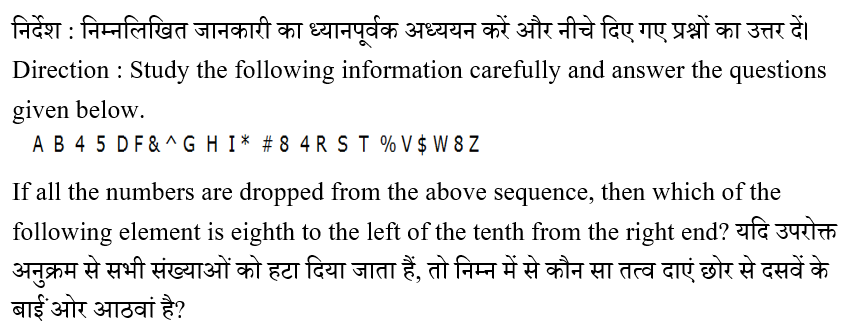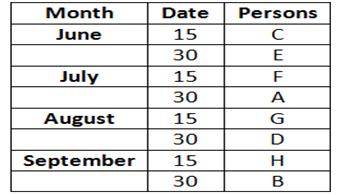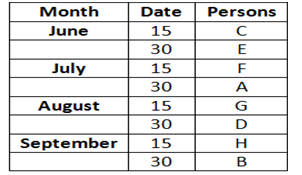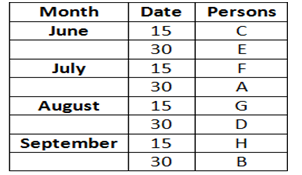Question 1:
निर्देश : दोनों निष्कर्षों को पढ़ें और फिर तय करें कि दिए गए निष्कर्षों में से कौन सा निष्कर्ष तार्किक रूप से दिए गए कथनों का अनुसरण करता है चाहे सर्वज्ञात तथ्य कुछ भी हों।
Direction : Read both the conclusions and then decide which of the given conclusions logically follows from the given statements disregarding commonly known facts.
Give Answer: उत्तर दें:
(1) If Only conclusion I follows. यदि केवल निष्कर्ष I अनुसरण करता है
(2) If Only conclusion II follows. यदि केवल निष्कर्ष II अनुसरण करता है
(3) If either conclusion I or II follows. यदि या तो निष्कर्ष I या II अनुसरण करता है
(4) If Neither conclusion I nor II follows. यदि न तो निष्कर्ष I न II अनुसरण करता है
(5) If both conclusions I and II follow. यदि दोनों निष्कर्ष I और II अनुसरण करता है
Statements: All set are pair Some pair are couple Some couple are single
कथन: सभी सेट पेयर है, कुछ पेयर कपल है, कुछ कपल सिंगल है
Conclusions: निष्कर्ष:
I. All single are pair सभी सिंगल पेयर है
II. Some single are not pair कुछ सिंगल पेयर नहीं है
Question 2:
निर्देश : दोनों निष्कर्षों को पढ़ें और फिर तय करें कि दिए गए निष्कर्षों में से कौन सा निष्कर्ष तार्किक रूप से दिए गए कथनों का अनुसरण करता है चाहे सर्वज्ञात तथ्य कुछ भी हों।
Direction : Read both the conclusions and then decide which of the given conclusions logically follows from the given statements disregarding commonly known facts.
Give Answer: उत्तर दें:
(1) If Only conclusion I follows. यदि केवल निष्कर्ष I अनुसरण करता है
(2) If Only conclusion II follows. यदि केवल निष्कर्ष II अनुसरण करता है
(3) If either conclusion I or II follows. यदि या तो निष्कर्ष I या II अनुसरण करता है
(4) If Neither conclusion I nor II follows. यदि न तो निष्कर्ष I न II अनुसरण करता है
(5) If both conclusions I and II follow. यदि दोनों निष्कर्ष I और II अनुसरण करता है
Statements: Some student are teacher
कथन: कुछ स्टूडेंट टीचर है,
No teacher are principal कोई टीचर प्रिन्सिपल नहीं है
All principal are watchman सभी प्रिन्सिपल वाचमैन है
Conclusions: निष्कर्ष:
I. Some student are principalकुछ स्टूडेंट प्रिन्सिपल है
II. All teacher being watchman is a possibility. सभी टीचर के वाचमैन होने की संभावना है
Question 3:
निर्देश : निम्नलिखित जानकारी का ध्यानपूर्वक अध्ययन करें और नीचे दिए गए प्रश्नों का उत्तर दें।
Direction : Study the following information carefully and answer the questions given below.
आठ व्यक्ति A, B, C, D, E, F, G, और H विभिन्न महीनों जून, जुलाई, अगस्त और सितंबर में सेमिनार में भाग लेते हैं लेकिन जरूरी नहीं कि उसी क्रम में। वे महीने के अलग-अलग दिनांक 15 और 30 में सेमिनार में भाग लेते हैं।
Eight persons A, B, C, D, E, F, G, and H attend the seminar in different months June, July, August and September but not necessarily in the same order. They attend the seminar in different dates 15th and 30th of the month.
B महीने के 15 तारिख को सेमिनार में भाग नहीं लेता है। G और B के बीच सेमिनार में केवल दो व्यक्ति भाग लेते हैं। C, जून के महीने में सेमिनार में भाग लेता है। H, 15 तारिख को सेमिनार में भाग लेता है लेकिन E के तुरंत बाद या तुरंत पहले नहीं लेता है। A और D के बीच केवल एक व्यक्ति सेमिनार में भाग लेता है। E, उस महीने में सेमिनार में भाग नहीं लेता है जिसमें 31 दिन हैं। A और C के बीच सेमिनार में दो व्यक्ति भाग लेते हैं। G, A के तुरंत बाद सेमिनार में भाग लेता है और दोनों अलग-अलग महीनों में सेमिनार में भाग लेते हैं। B, 30 दिनों वाले महीने में सेमिनार में भाग लेता है। H, जुलाई के महीने में सेमिनार में भाग नहीं लेता है।
B doesn’t attend the seminar on 15th of the month. Only two persons attend the seminar between G and B. C attends the seminar in the month of June. H attends the seminar on 15th but not an immediately after or immediately before E. Only one person attends the seminar between A and D. E doesn’t attend the seminar in a month which has 31 days. Two persons attend the seminar between A and C. G attends the seminar immediately after A and both of them attend the seminar on different months. B attends the seminar in a month has 30 days. H does not attend the seminar in the month of July.
Which among the following persons attend the seminar on July month?
निम्नलिखित में से कौन सा व्यक्ति जुलाई महीने में सेमिनार में भाग लेता है?
Question 4:
निर्देश : निम्नलिखित जानकारी का ध्यानपूर्वक अध्ययन करें और नीचे दिए गए प्रश्नों का उत्तर दें।
Direction : Study the following information carefully and answer the questions given below.
आठ व्यक्ति A, B, C, D, E, F, G, और H विभिन्न महीनों जून, जुलाई, अगस्त और सितंबर में सेमिनार में भाग लेते हैं लेकिन जरूरी नहीं कि उसी क्रम में। वे महीने के अलग-अलग दिनांक 15 और 30 में सेमिनार में भाग लेते हैं।
Eight persons A, B, C, D, E, F, G, and H attend the seminar in different months June, July, August and September but not necessarily in the same order. They attend the seminar in different dates 15th and 30th of the month.
B महीने के 15 तारिख को सेमिनार में भाग नहीं लेता है। G और B के बीच सेमिनार में केवल दो व्यक्ति भाग लेते हैं। C, जून के महीने में सेमिनार में भाग लेता है। H, 15 तारिख को सेमिनार में भाग लेता है लेकिन E के तुरंत बाद या तुरंत पहले नहीं लेता है। A और D के बीच केवल एक व्यक्ति सेमिनार में भाग लेता है। E, उस महीने में सेमिनार में भाग नहीं लेता है जिसमें 31 दिन हैं। A और C के बीच सेमिनार में दो व्यक्ति भाग लेते हैं। G, A के तुरंत बाद सेमिनार में भाग लेता है और दोनों अलग-अलग महीनों में सेमिनार में भाग लेते हैं। B, 30 दिनों वाले महीने में सेमिनार में भाग लेता है। H, जुलाई के महीने में सेमिनार में भाग नहीं लेता है।
B doesn’t attend the seminar on 15th of the month. Only two persons attend the seminar between G and B. C attends the seminar in the month of June. H attends the seminar on 15th but not an immediately after or immediately before E. Only one person attends the seminar between A and D. E doesn’t attend the seminar in a month which has 31 days. Two persons attend the seminar between A and C. G attends the seminar immediately after A and both of them attend the seminar on different months. B attends the seminar in a month has 30 days. H does not attend the seminar in the month of July.
H attends the seminar in which of the following date and month?
H, निम्नलिखित किस तारीख और महीने में सेमिनार में भाग लेता है?
Question 5:
निर्देश : निम्नलिखित जानकारी का ध्यानपूर्वक अध्ययन करें और नीचे दिए गए प्रश्नों का उत्तर दें।
Direction : Study the following information carefully and answer the questions given below.
आठ व्यक्ति A, B, C, D, E, F, G, और H विभिन्न महीनों जून, जुलाई, अगस्त और सितंबर में सेमिनार में भाग लेते हैं लेकिन जरूरी नहीं कि उसी क्रम में। वे महीने के अलग-अलग दिनांक 15 और 30 में सेमिनार में भाग लेते हैं।
Eight persons A, B, C, D, E, F, G, and H attend the seminar in different months June, July, August and September but not necessarily in the same order. They attend the seminar in different dates 15th and 30th of the month.
B महीने के 15 तारिख को सेमिनार में भाग नहीं लेता है। G और B के बीच सेमिनार में केवल दो व्यक्ति भाग लेते हैं। C, जून के महीने में सेमिनार में भाग लेता है। H, 15 तारिख को सेमिनार में भाग लेता है लेकिन E के तुरंत बाद या तुरंत पहले नहीं लेता है। A और D के बीच केवल एक व्यक्ति सेमिनार में भाग लेता है। E, उस महीने में सेमिनार में भाग नहीं लेता है जिसमें 31 दिन हैं। A और C के बीच सेमिनार में दो व्यक्ति भाग लेते हैं। G, A के तुरंत बाद सेमिनार में भाग लेता है और दोनों अलग-अलग महीनों में सेमिनार में भाग लेते हैं। B, 30 दिनों वाले महीने में सेमिनार में भाग लेता है। H, जुलाई के महीने में सेमिनार में भाग नहीं लेता है।
B doesn’t attend the seminar on 15th of the month. Only two persons attend the seminar between G and B. C attends the seminar in the month of June. H attends the seminar on 15th but not an immediately after or immediately before E. Only one person attends the seminar between A and D. E doesn’t attend the seminar in a month which has 31 days. Two persons attend the seminar between A and C. G attends the seminar immediately after A and both of them attend the seminar on different months. B attends the seminar in a month has 30 days. H does not attend the seminar in the month of July.
Which of the following person attend the seminar immediately after the one who attends the seminar on July 30th?
30 जुलाई को सेमिनार में भाग लेने वाले व्यक्ति के तुरंत बाद निम्नलिखित कौन सा व्यक्ति सेमिनार में भाग लेता है?
Question 6:
निर्देश : निम्नलिखित जानकारी का ध्यानपूर्वक अध्ययन करें और नीचे दिए गए प्रश्नों का उत्तर दें।
Direction : Study the following information carefully and answer the questions given below.
आठ व्यक्ति A, B, C, D, E, F, G, और H विभिन्न महीनों जून, जुलाई, अगस्त और सितंबर में सेमिनार में भाग लेते हैं लेकिन जरूरी नहीं कि उसी क्रम में। वे महीने के अलग-अलग दिनांक 15 और 30 में सेमिनार में भाग लेते हैं।
Eight persons A, B, C, D, E, F, G, and H attend the seminar in different months June, July, August and September but not necessarily in the same order. They attend the seminar in different dates 15th and 30th of the month.
B महीने के 15 तारिख को सेमिनार में भाग नहीं लेता है। G और B के बीच सेमिनार में केवल दो व्यक्ति भाग लेते हैं। C, जून के महीने में सेमिनार में भाग लेता है। H, 15 तारिख को सेमिनार में भाग लेता है लेकिन E के तुरंत बाद या तुरंत पहले नहीं लेता है। A और D के बीच केवल एक व्यक्ति सेमिनार में भाग लेता है। E, उस महीने में सेमिनार में भाग नहीं लेता है जिसमें 31 दिन हैं। A और C के बीच सेमिनार में दो व्यक्ति भाग लेते हैं। G, A के तुरंत बाद सेमिनार में भाग लेता है और दोनों अलग-अलग महीनों में सेमिनार में भाग लेते हैं। B, 30 दिनों वाले महीने में सेमिनार में भाग लेता है। H, जुलाई के महीने में सेमिनार में भाग नहीं लेता है।
B doesn’t attend the seminar on 15th of the month. Only two persons attend the seminar between G and B. C attends the seminar in the month of June. H attends the seminar on 15th but not an immediately after or immediately before E. Only one person attends the seminar between A and D. E doesn’t attend the seminar in a month which has 31 days. Two persons attend the seminar between A and C. G attends the seminar immediately after A and both of them attend the seminar on different months. B attends the seminar in a month has 30 days. H does not attend the seminar in the month of July.
How many persons attend the seminar between H and G?
H और G के बीच सेमिनार में कितने व्यक्ति भाग लेते हैं?
Question 7:
निर्देश : निम्नलिखित जानकारी का ध्यानपूर्वक अध्ययन करें और नीचे दिए गए प्रश्नों का उत्तर दें।
Direction : Study the following information carefully and answer the questions given below.
आठ व्यक्ति A, B, C, D, E, F, G, और H विभिन्न महीनों जून, जुलाई, अगस्त और सितंबर में सेमिनार में भाग लेते हैं लेकिन जरूरी नहीं कि उसी क्रम में। वे महीने के अलग-अलग दिनांक 15 और 30 में सेमिनार में भाग लेते हैं।
Eight persons A, B, C, D, E, F, G, and H attend the seminar in different months June, July, August and September but not necessarily in the same order. They attend the seminar in different dates 15th and 30th of the month.
B महीने के 15 तारिख को सेमिनार में भाग नहीं लेता है। G और B के बीच सेमिनार में केवल दो व्यक्ति भाग लेते हैं। C, जून के महीने में सेमिनार में भाग लेता है। H, 15 तारिख को सेमिनार में भाग लेता है लेकिन E के तुरंत बाद या तुरंत पहले नहीं लेता है। A और D के बीच केवल एक व्यक्ति सेमिनार में भाग लेता है। E, उस महीने में सेमिनार में भाग नहीं लेता है जिसमें 31 दिन हैं। A और C के बीच सेमिनार में दो व्यक्ति भाग लेते हैं। G, A के तुरंत बाद सेमिनार में भाग लेता है और दोनों अलग-अलग महीनों में सेमिनार में भाग लेते हैं। B, 30 दिनों वाले महीने में सेमिनार में भाग लेता है। H, जुलाई के महीने में सेमिनार में भाग नहीं लेता है।
B doesn’t attend the seminar on 15th of the month. Only two persons attend the seminar between G and B. C attends the seminar in the month of June. H attends the seminar on 15th but not an immediately after or immediately before E. Only one person attends the seminar between A and D. E doesn’t attend the seminar in a month which has 31 days. Two persons attend the seminar between A and C. G attends the seminar immediately after A and both of them attend the seminar on different months. B attends the seminar in a month has 30 days. H does not attend the seminar in the month of July.
Which of the following person attend the seminar immediately before F? निम्नलिखित में से कौन सा व्यक्ति F से तुरंत पहले सेमिनार में भाग लेता है?
Question 8: 
Question 9: 
Question 10: 










